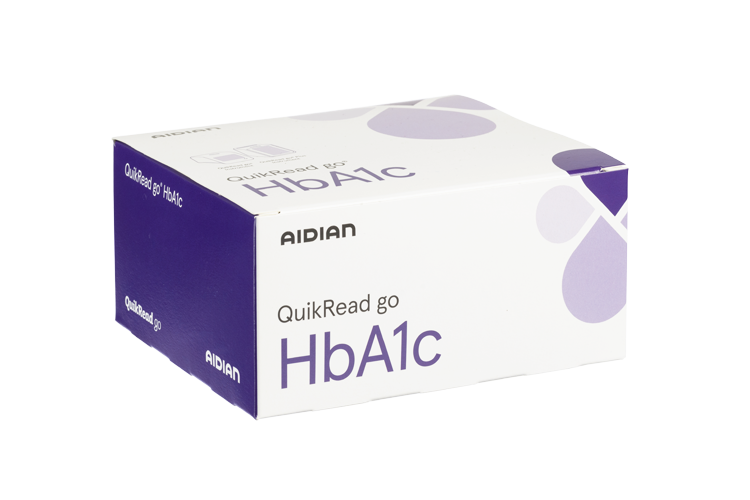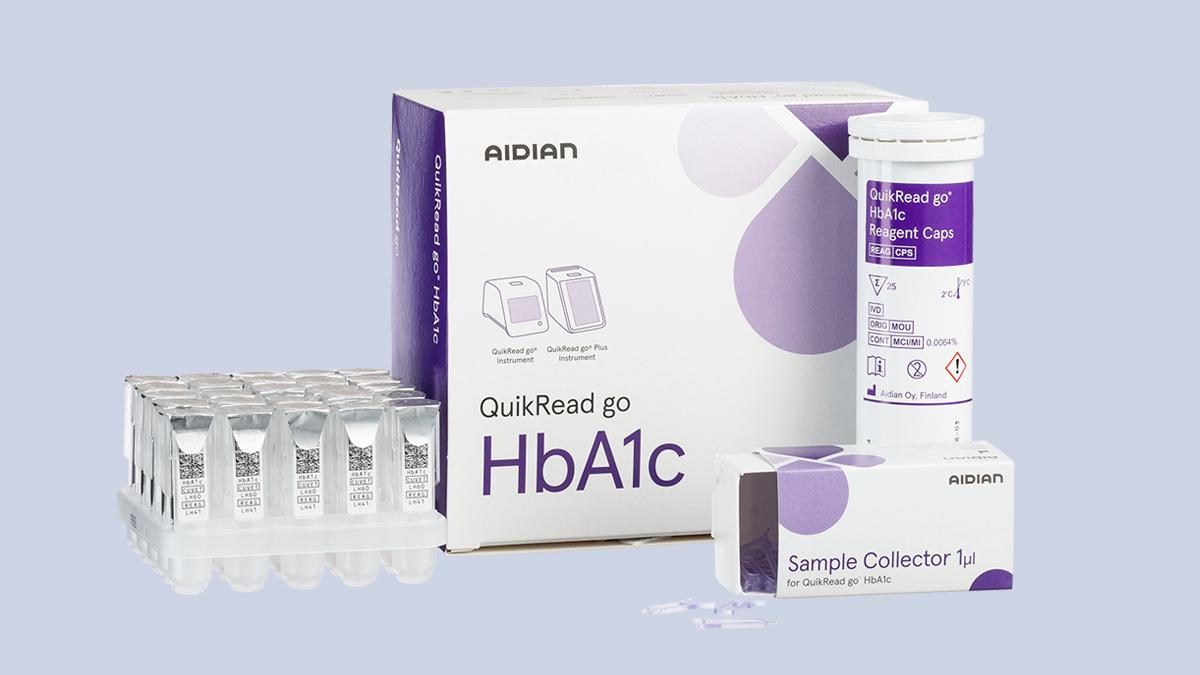QuikRead go HbA1c
QuikRead go HbA1c is an intuitive and reliable point of care test for quantitative measurement of glycated haemoglobin (HbA1c) from a capillary finger prick or venous whole blood sample with Quikread go instrument. The one-step sample collector used with QuikRead go HbA1c kit minimizes hands-on steps and enables easy point of care HbA1c testing.

Generally
QuikRead go HbA1c for improved management of diabetes1,2
A quantitative HbA1c result can be used as an aid in the diagnosis of diabetes mellitus, in the monitoring of long-term blood glucose control in individuals with diabetes mellitus, and in identifying patients at risk of developing diabetes mellitus. Point of care HbA1c testing has shown to improve diabetes management, patient’s commitment to treatment and patient satisfaction.1,2

Simple testing procedure
- Unique one-step sample collector eases the sample collection and improves workflow
- Tiny 1 µl sample volume
- Capillary finger prick or venous whole blood sample
Reliable results quickly
- Analysis time less than 6 minutes
- 5 minutes of sample stability in the cuvette
- HbA1c measuring range 20-140 mmol/mol (4-15 %)
- IFCC certified
Effortless testing with the QuikRead go multianalyte instrument
- Ready-to-use reagents
- Fully automated measurement
- Maintenance free
- Battery use ensures full portability
- Bi-directional connectivity to most HIS and LIS systems
Test results should never be used alone without a complete clinical evaluation. QuikRead go HbA1c is not registered in the USA.
References
1. Miller CD et al. Rapid A1c availability improves clinical decision-making in an urban primary care clinic. Diabetes Care 2003; 26(4): 1158-1163.
2. Schnell O et al. Impact of HbA1c Testing at Point of Care on Diabetes Management. J Diabetes Sci Technol 2017; 11(3):611-617.
Technical data
| Products available |
|
| Use | For in vitro diagnostic use, IVD CE |
| Method | Immunoturbidimetric |
| Sample type | Whole blood |
| Instrument information | QuikRead go system instruments |
| Measurement time | 5 minutes 50 seconds |
| Reading of the result | Instrument read |
| Storage | 2 – 8 ºC |
| Additionally needed |
|
| Registered trademark | QuikRead go is a registered trademark of Aidian Oy |
| Country of origin | Finland |
| Registration | Not registered in the USA |
| Size and weight | 160 x 140 x 76 mm |
HbA1c in diabetes management
Understanding Diabetes
Diabetes is a chronic condition that affects more than 1 out of 10 people.1 In diabetes, the body either does not produce enough insulin (type 1 diabetes) or cannot effectively use the insulin it produces (type 2 diabetes), as is the case in 90% of the diabetes cases. Insulin is a hormone that is needed to allow glucose move to cells for energy production. It is estimated that approximately 50% of patients with type 2 diabetes, are undiagnosed.1
HbA1c is a convenient tool in diagnosis of diabetes
Glycated haemoglobin, HbA1c, represents the average blood glucose levels of the past 2-3 months. HbA1c can be used as an aid in the diagnosis of diabetes, prediabetes, and in screening of patients at risk for developing diabetes.
Clinical guidelines globally recommend either one of the three available methods for diagnosing diabetes:2-4
- HbA1c
- fasting plasma glucose (FPG)
- 2h plasma glucose value after a 75g oral glucose tolerance test (OGTT)
Diabetes requires continuous care
Without proper management, diabetes can lead to excessively high blood glucose levels, which can cause long-term complications in the cardiovascular system, eyes, nerves, and kidneys. A large proportion of patients diagnosed with diabetes do not meet their individual glyceamic goals due to non-adherence to treatment or inadequate treatment strategies.5 The key to effective diabetes management is maintaining normal glucose levels to avoid or delay complications associated with high blood glucose and to maintain quality of life.
Improving diabetes care with HbA1c monitoring
Glycaemic control of diabetic patients is monitored using HbA1c and blood glucose measurements with glucose meters or subcutaneously inserted continuous glucose monitors. The HbA1c measurement reflects the long-term plasma glucose levels, whereas plasma glucose measurements provide information about the current glucose level present at the time of measurement. HbA1c is recommended as a primary tool for monitoring glycaemic control in continuous diabetes care.2,6,7 It’s use in monitoring is particularly convenient, as it is not affected by dietary intake and does not require fasting.
Point of care HbA1c testing provides substantial benefits in healthcare
Point of care HbA1c testing offers substantial benefits in healthcare settings, improving both patient outcomes and clinical efficiency. This is how HbA1c point of care testing transforms diabetes care:5,8
- Immediate results: finger prick samples and results that are available during patient consultation allow immediate medical decisions and improve patient outcomes.
- Early diagnosis: when diabetes or prediabetes is diagnosed the chance of developing type 2 diabetes and complications reduces
- Enhanced treatment adherence: point of care testing helps to improve patient adherence to treatment, leading to better overall treatment outcomes.
- Increased patient satisfaction: patients appreciate the convenience and rapid results, which enhances their overall satisfaction.
References
- International Diabetes Federation. IDF Diabetes atlas, 10th edition 2021.
- International Diabetes Federation. Recommendations for managing Type 2 Diabetes in Primary Care 2017.
- American Diabetes Association Professional Practice Committee. 2. Diagnosis and Classification of Diabetes: Standards of Care in Diabetes—2024. Diabetes Care 2024; 47:S20-S42.
- Cosentino F et al. 2019 ESC Guidelines on diabetes, pre-diabetes, and cardiovascular diseases developed in collaboration with the EASD: The Task Force for diabetes, pre-diabetes, and cardiovascular diseases of the European Society of Cardiology (ESC) and the European Association for the Study of Diabetes (EASD). Eur Heart J 2019.
- Schnell O et al. Impact of HbA1c Testing at Point of Care on Diabetes Management. J Diabetes Sci Technol
2016; 11:611-617. - American Diabetes Association Professional Practice Committee. 6. Glycemic Goals and Hypoglycemia:
Standards of Care in Diabetes—2024. Diabetes Care 2024; 47:S111–S125. - World Health Organization (WHO). Diagnosis and Management of Type 2 Diabetes (HEARTS-D), 2020.
- Gourlay A et al. Point-of-Care testing of HbA1c levels in community settings for people with established
diabetes or people at risk of developing diabetes: A systematic review and meta-analysis. Primary Care
Diabetes 2024; 18:7-16.
Documents and materials
Marketing and sales materials
QuikRead go HbA1c Brief Instructions (EN)
QuikRead go HbA1c POC Benefits Flyer (EN)
QuikRead go Plus Family Brochure (EN)
QuikRead go Family Brochure (EN)
QuikRead go Technical Specifications (EN)
QuikRead go Plus Technical Specifications (EN)
QuikRead go Sample Collector 10µl & 1µl Blood Sampling Instructions (EN)
QuikRead go Control Information (EN)
QuikRead go workstation Flyer (EN)
Scientific materials
QuikRead go HbA1c Poster AACC 2020 (EN)
QuikRead go HbA1c Poster IFBLS 2021 (EN)
QuikRead go HbA1c Poster July 2022 (EN)
QuikRead go HbA1c Poster DGKL 2023 (EN
Instructions for use
(For informative use only. Kindly always refer to the latest package insert in the kit.)
QuikRead go HbA1c IFU (GB, DE, FR, NL), 154470
QuikRead go HbA1c IFU (FI, SE, NO, DK), 154563
QuikRead go HbA1c IFU (CZ, SK, HU, PL), 154581
QuikRead go HbA1c IFU (IT, ES, EE, LT), 154580
Safety Data Sheet
If you wish to receive a Safety data sheet, please contact: product.support@aidian.eu
Videos
-
Test videos using QuikRead go Instrument
-
Test videos using QuikRead go Plus Instrument
Frequently asked questions
I would like to start using the QuikRead go HbA1c test. Which instrument software version I need on my QuikRead go Instrument?
You should have the version 8.1.1. or newer. This software is suitable also for all of the other test kits that we provide.
Which sample collector is suitable for the QuikRead go HbA1c test?
QuikRead go Sample Collectors 1µl, which are included in the QuikRead go HbA1c test kit, must be used for sample collection and transferring the sample or control into the QuikRead go HbA1c cuvettes.
Which sample types are suitable for QuikRead go HbA1c test?
Suitable sample types for QuikRead go HbA1c test are a finger prick capillary blood and anticoagulated venous whole blood sample. Only 1 µl of blood is required for the test. When taking the sample from finger prick, remember to wipe off the first drop.


